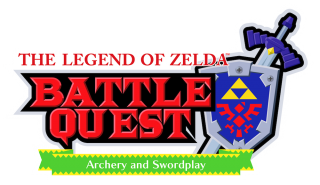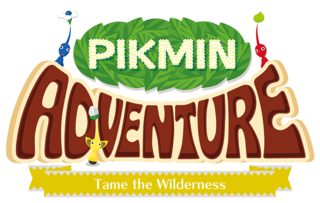Overview
Nintendo Land is a Nintendo theme park video game that was a launch title for the Wii U.
Gameplay
Twelve different games each based on different Nintendo franchises are included and can be accessed via a hub area disguised as a theme park. Players select which of the mini-games to play by walking up to the given ride within the theme park. The hub world is populated by a combination of the Miis of the player's friend list in addition to a selection of randomly generated Miis. Coins, earned through playing the different mini-games, can be used to play a pachinko machine located in the hub world plaza. The prizes for winning the pachinko game in turn results in certain events or prizes such as a Zelda-themed Mii-parade or the appearance of other Nintendo-themed memorabilia.
Single and Multiplayer Hybrid Games
The Legend of Zelda: Battle Quest

Origin: The Legend of Zelda
In this on-rails mini-game, players use motion controls for sword fighting and archery in a similar way as The Legend of Zelda: Skyward Sword. The way the game is structured is very reminiscent of the "Showdown" mode from Wii Sports Resort where players were guided on-rails through a map while fighting off enemies with their swords.
Multiplayer Mode
In Battle Quest, up to three players take on the role of the sword fighters using Wii remotes, while a fourth player moves the Wii U GamePad around to aim a bow and arrow. The enemy designs are very similar to the ones found in Skyward Sword; for example, there are small mechanical creatures that are marked across their whole ball-shaped body by lines in varying angles that indicate in which way sword slices will hurt them.
Single Player Mode
In single player, the game offers a time attack mode. There are also three separate archery-focused stages.
Battle Quest requires Wii Remote Plus (or Wii Remotes with Wii MotionPlus attachments) controllers.
Pikmin Adventure

Origin: Pikmin
Pikmin Adventure, unlike the original games, features more fast paced action than strategy. Up to five players can play together, either cooperatively or competitively. The player with the GamePad controls Captain Olimar and his posse of tiny Pikmin. Other players use Wii remotes to control Miis dressed up as Pikmin. Olimar has his usual control options, like calling back all Pikmin (incl. the Mii players), or throwing his tiny Pikmin at enemies. The game is reminiscent of The Legend of Zelda: Four Swords Adventures with its light action RPG mechanics. For example, Pikmin players can pick up items and level up to become stronger.
Pikmin Adventure features a cooperative challenge mode with 16 levels for 1 to 5 players, as well as a versus mode with 5 stages for between 2 and 5 players. The versus mode pits Captain Olimar against the Pikmin-dressed Miis.
Metroid Blast

Origin: Metroid
Metroid Blast was revealed as part of Game Informer's September 2012 issue which covered many Wii U details. As was to be expected, Metroid Blast is based on "Battle Mii"; a tech demo originally demonstrated at E3 2011. The Battle Mii demo was a shooting game that had one player in Samus's ship on the GamePad screen, and two players dressed in Metroid-style power suits attempting to shoot it down using Wii remote controls.
Land vs. Air Mode

The previously mentioned "Battle Mii" tech demo was what became Metroid Blast's Land vs. Air mode. In the final version, up to four players can play splitscreen in third-person shooter mode; one additional player can pilot the Gunship with the GamePad through stages inspired by the Metroid games.
Assault Mission Mode

This mode is a variation on the wave-based survival mode formula. While the other two modes in Metroid Blast are competitive, this features cooperative gameplay. The player with the GamePad (controlling the Gunship), and the players with Wii remotes (controlling the Samus-Miis) have to work together to take out waves of enemies, and eventually, a final boss from the Metroid franchise. The players on the ground can use the Grapple Beam to hang off of the Gunship, which can transport the other players around to help them avoid damage and move around quicker. Assault Mode features 20 stages.
Ground vs. Ground Mode
Metroid Blast also features a deathmatch mode where all players are on the ground, trying to take each other out. This mode features 5 unique stages.
Multiplayer-Only Games
These attractions scale based on the amount of players. The game may be populated with various A.I. characters, or the gameplay rules might change slightly to accommodate the smaller number of participants.
Luigi's Ghost Mansion

Origin: Luigi's Mansion
Luigi's Ghost Mansion is heavily inspired by Shigeru Miyamoto's own Pac Man Vs. for the GameCube. Luigi's Ghost Mansion conceals one player's location as they play stealthily as the ghost on the GamePad screen; simultaneously, up to four other players control Mii characters with flashlights. The Mii players' goal is to catch the ghost with their flashlights before the ghost takes them out from the shadows. Mii players are notified of the ghost-player's presence by a rumble of their Wii Remote controllers. The ghost can eliminate players who then have to be slowly revived by their teammates, allowing the ghost to set a trap. The other players have to pick up batteries on the map to keep their flashlights running without which they are defenseless against the ghost.
Animal Crossing: Sweet Day

Origin: Animal Crossing
Animal Crossing: Sweet Day allows up to five players to participate. One player plays solely on the GamePad screen but actually controls two characters at once with each analog stick. The Wii Remote players have to steal all of the fruit from the map; the more fruit they collect, the harder it is for them to get around. The GamePad player's challenge lies in controlling two characters simultaneously with the sticks and keeping track of all the other characters on the large map to find them before they steal all the fruit.
Mario Chase

Origin: Super Mario Bros.
Mario Chase was demoed as "Chase Mii" at E3 2011. Up to five players play a game of hide and seek. The player with the GamePad is dressed as Mario and has to run and hide. The other four players are dressed as Toads as they chase Mario around one of three different stages. The Toads cannot see the location of Mario and must communicate verbally in order to catch him.
Singleplayer-Only Games
Takamaru's Ninja Castle

Origin: Nazo no Murasamejou
This is the most straightforward of all the mini games. It works similarly to the Archery mini game in Wii Sports Resort. Utilizing the motion and gyro sensors, players hold the Wii U GamePad flat and pointed vertically at the TV in their right or left hand. They then swipe ninja stars off the touch screen in order to hit targets displayed on their TV. The player uses the speed of their swipe and the orientation of the GamePad to aim. Players must try to hit ninjas consecutively without missing to earn combo points. Takamaru's inclusion is the most curious among the other games since the game it is based on was only ever released in Japan for the Famicom.
Captain Falcon's Twister Race

Origin: F-Zero
This attraction has the player controlling a Mii that is piloting the Blue Falcon around a typical F-Zero course with the Nintendo Land art style. The track features obstacles such as civilian cars and small tornadoes.
The game is controlled by holding the Wii U GamePad vertically and tilting it to guide the vehicle to the finish line via motion controls. The TV displays a traditional racing-game perspective from behind the vehicle while the GamePad shows an overhead view. Going through tunnels obscures the view on the GamePad, at which point the player has to focus on the TV. The game is basically a time trial through an obstacle course since no other players are present, and evading traffic while navigating sharp turns is the main mechanic. While the vehicles don't reach the insane speeds as in proper F-Zero titles, the game's course design supposedly still offers a great challenge which is very much in the spirit of the franchise.
Balloon Trip Breeze

Origin: Balloon Fight
Also revealed in Game Informer magazine, this game is inspired by the NES-classic Balloon Fight. The game is controlled by drawing gusts of wind with a stylus or finger on the touch screen (reminiscent of the LostWinds games) to pilot Miis in balloons across the levels. The only goal is to go as far as possible while avoiding various obstacles. This mode is meant to encourage competitiveness for high scores shared via the Miiverse. The GamePad view features a zoomed-in perspective on the player, while the TV displays of the level. This means the player will have to balance their focus between the two screens to be successful.
Donkey Kong's Crash Course

Origin: Donkey Kong
In Donkey Kong's Crash Course, the player must navigate a 2D obstacle course in a fragile vehicle by tilting the GamePad. Similarly to Ballon Trip Breeze, a close up view of the vehicle is shown on the touch screen, while the full course is displayed on the TV. The player has to watch out for impact velocity and hazardous obstacles that can destroy the vehicle and reset it to the latest check point. The game features a chalkboard aesthetic and features the red girders from the source material prominently.
Octopus Dance

Origin: Game & Watch
Octopus Dance is a rhythm game that has players memorize the character's movements on screen and replicate them either with the analog sticks, or with motion controls. The TV and GamePad views alternate between a head on frontal perspective, and a view from behind the player character. Occasionally, one screen gets obstructed by black ink from the octopus that hangs out in the background. Additionally, the camera captures the player's face during gameplay and displays it on a submarine in the background for the amusement of onlookers.
Yoshi's Fruit Cart

Origin: Yoshi
Players have to draw a path for Yoshi's cart toward the goal while avoiding obstacles and collecting fruit along the way. However, the fruit and obstacles are only displayed on the TV; therfore the course must basically be drawn blindly. Sometimes, the fruit is numbered and has to be picked up in that particular order to unlock the gate at the end. If the player can't collect all the fruit, the gate won't open and a life is lost, resetting the course. This attraction features 50 stages, some of which can be skipped via warp-pipes.
Attraction Tour
In addition to visiting each attraction individually, the game also offers an Attraction Tour mode. In this mode, up to five players compete across all twelve of the game's attractions. At the end of each attraction players are awarded points with the player that has the most points at the end of all rounds being declared the winner. The tour can last three, six, nine or twelve rounds.
Single player attractions are also included in the tour. In these attractions several of the players take turns to compete for the best score. However, to keep rounds shorter these events are usually limited to two of the players, other players can still earn points by betting on the winner at the start of the round.
At the end of each round, the gamepad is passed to another player who chooses the attraction for the next round from a randomly selected pool of five options.
Reception
As of September 30 2016, Nintendo Land has sold 5.13 million copies worldwide.
Log in to comment